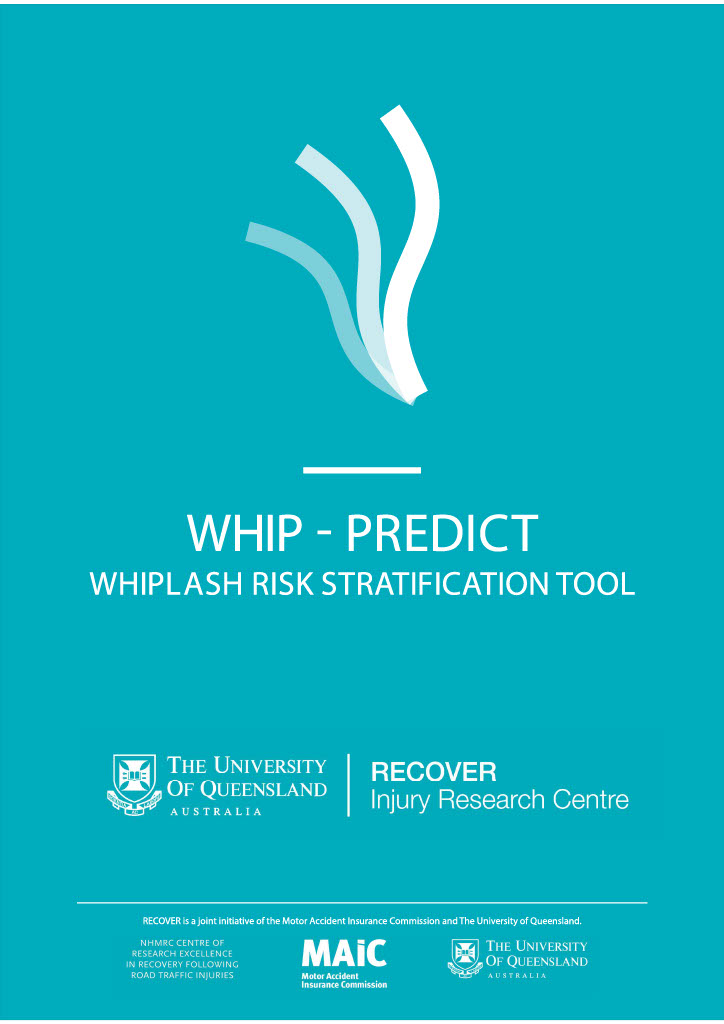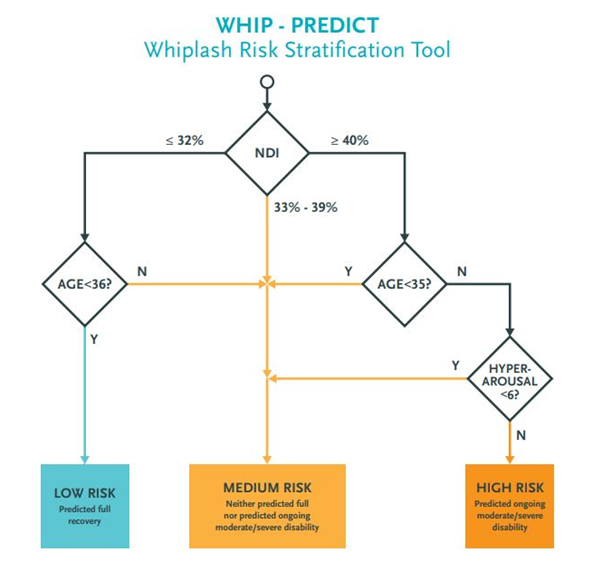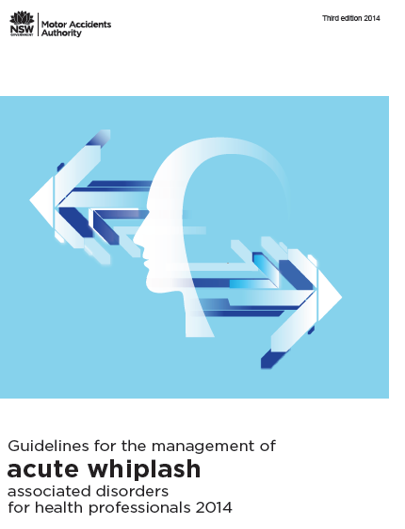WhipPredict: Risk stratification for whiplash
What is WhipPredict?
 The WhipPredict tool is a risk stratification tool for use by clinicians with patients who present with acute whiplash.
The WhipPredict tool is a risk stratification tool for use by clinicians with patients who present with acute whiplash.
A whiplash risk stratification tool is a research-generated tool used to predict outcomes such as the likelihood of developing moderate/severe disability or experiencing full recovery from whiplash injury.
Developed by Professor Michele Sterling and colleagues, WhipPredict is underpinned by an extensive research evidence-base and has the support of the Australian Physiotherapy Association.
Why use WhipPredict?
Recovery following a whiplash injury is varied. While approximately 50 per cent of individuals fully recover, 25 per cent develop persistent moderate/severe pain and disability and 25 per cent experience milder levels of disability.
In our earlier studies, we observed increased probability of developing chronic moderate/severe disability in the presence of older age and initially higher levels of neck disability index (NDI) and hyperarousal symptoms, and increased probability of full recovery in younger individuals with initially lower levels of NDI.
Compared to other risk stratification tools, WhipPredict was designed to predict ongoing pain-related disability. WhipPredict, with higher sensitivity, will correctly identify a higher proportion of patients who will not recover when recovery is defined in terms of pain, disability, or perceived recovery.
WhipPredict’s inbuilt questionnaire will help you assess the likelihood of recovery. Once your patient has completed the questionnaire and you have calculated the NDI and the hyperarousal symptoms (if applicable) scores, follow the diagram below to make a prediction about the likelihood of recovery.

Recommendations for the treatment of WAD
It is recommended that clinicians follow the recommendations outlined in the Australian Guidelines for the management of Acute Whiplash Associated Disorders for Health Professionals. In addition, the online resource My Whiplash Navigator, provides additional information, assessments and case studies to assist health professionals in caring for patients with whiplash associated disorders.
Access WhipPredict
Link to the PDF tool (PDF, 845.8 KB)
Research evidence
Griffin, A.R., Sterling, M., Ritchie, C. et al. Do expectations of recovery improve risk assessment for people with whiplash-associated disorders? Secondary analysis of a prospective cohort study. BMC Musculoskelet Disord 23, 395 (2022). https://doi.org/10.1186/s12891-022-05242-8.
Michele Sterling, Carrie Ritchie, Trudy Rebbeck, Ian D Cameron, Alex Griffin, Jagnoor Jagnoor, Michael Nicholas, Ha Nguyen, Jacelle Warren. Comparison of the Accuracy of WhipPredict to That of a Modified Version of the Short-Form Örebro Musculoskeletal Pain Screening Questionnaire to Predict Poor Recovery After Whiplash Injury. J Orthop Sports Phys Ther 2021;51(5):207-215. Epub 19 Feb 2021. doi:10.2519/jospt.2021.9987.
Joan Kelly, Carrie Ritchie, Michele Sterling. Agreement is very low between a clinical prediction rule and physiotherapist assessment for classifying the risk of poor recovery of individuals with acute whiplash injury. Musculoskeletal Science and Practice 39 (2019) 73-79, doi.org/10.1016/j.msksp.2018.11.003.
Carrie Ritchie, Joan Hendrikz, Gwendolen Jull, James Elliott, Michele Sterling. External Validation of a Clinical Prediction Rule to Predict Full Recovery and Ongoing Moderate/Severe Disability Following Acute Whiplash Injury. J Orthop Sports Phys Ther 2015;45(4):242-250. doi:10.2519/jospt.2015.5642
Ritchie, Carrie*; Hendrikz, Joan; Kenardy, Justin; Sterling, Michele. Derivation of a clinical prediction rule to identify both chronic moderate/severe disability and full recovery following whiplash injury. Pain 154(10):p 2198-2206, October 2013. | DOI: 10.1016/j.pain.2013.07.001
Australian Guidelines for the Management of Acute Whiplash Associated Disorders for Health Professionals
 Once the patient’s likelihood of recovery has been assessed through the use of WhipPredict, it is recommended to follow the treatments outlined in the Australian Guidelines for the management of Acute Whiplash Associated Disorders for Health Professionals. These Guidelines translate the current evidence base into clinical practice recommendations for the best possible management of adults with a whiplash injury in the first 12 weeks.
Once the patient’s likelihood of recovery has been assessed through the use of WhipPredict, it is recommended to follow the treatments outlined in the Australian Guidelines for the management of Acute Whiplash Associated Disorders for Health Professionals. These Guidelines translate the current evidence base into clinical practice recommendations for the best possible management of adults with a whiplash injury in the first 12 weeks.
The third edition of the Guidelines published in December 2014 is presently being reviewed, with the fourth edition due to be published in December 2023.
Access the current Guidelines
My Whiplash Navigator

My Whiplash Navigator is a resource for both consumers and clinicians. It is a self-directed program to guide people on how best to recover after a whiplash injury. Healthcare professionals can access up-to-date information on assessment for whiplash (what and how to assess) and optimal management.
Whiplash treatment options
Whiplash evidence based information resource is a resource providing evidence based information to the general public and health care professionals about whiplash and its management.
